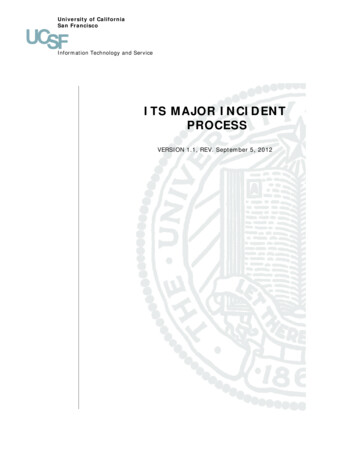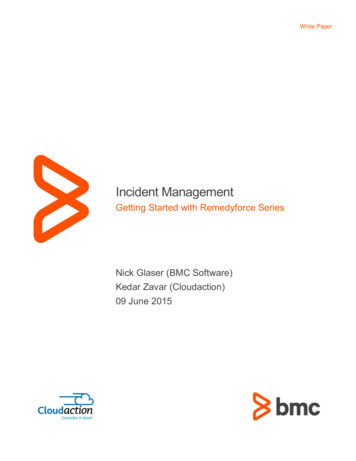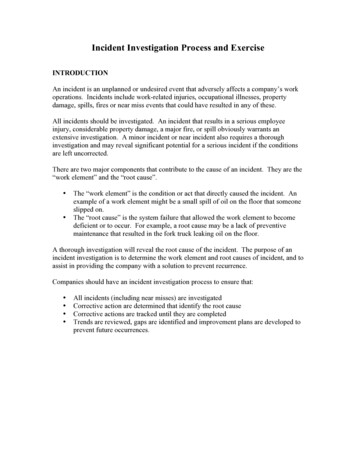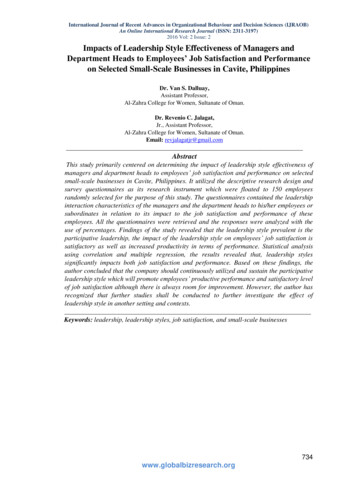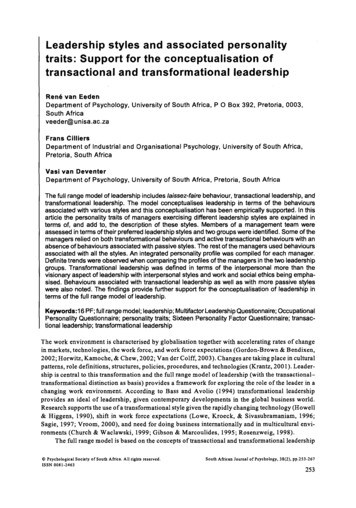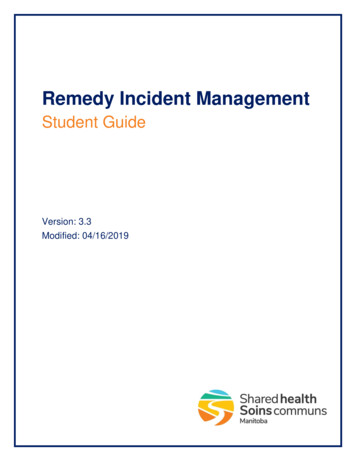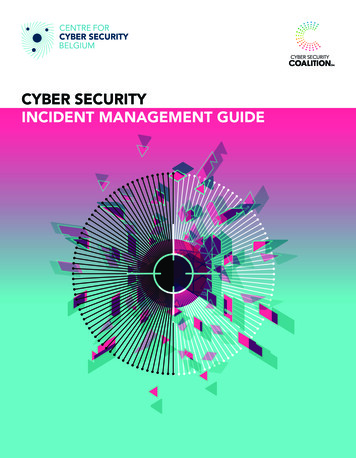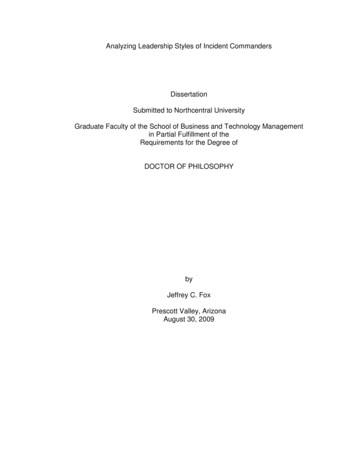
Transcription
Analyzing Leadership Styles of Incident CommandersDissertationSubmitted to Northcentral UniversityGraduate Faculty of the School of Business and Technology Managementin Partial Fulfillment of theRequirements for the Degree ofDOCTOR OF PHILOSOPHYbyJeffrey C. FoxPrescott Valley, ArizonaAugust 30, 2009
Copyright 2009Jeffrey C. Fox
APPROVALAnalyzing Leadership Styles of Incident CommandersbyJeffrey C. FoxApproved by:Olin O. Oedekoven, Ph.D.Chair: (Type name and degree)DateMember: Yvonne Doll, Ph.D.Member: Lionel Rawlins, Ph.D.Certified by:School Chair (Lynn Payne, Ph.D.)Date
ABSTRACTIn this mixed methods study, the prevalence of transformational, transactional,and laissez-faire leadership styles among incident commanders during incidentsthat utilized a unified command (UC) was examined, and differences betweendisciplines in leadership styles were investigated. The problem addressed wasthat it is currently unknown whether there is a dominant leadership styleassociated with incident commanders during an incident. The problem thiscreates is that it cannot be determined if a UC is affected positively or negativelyby different or specific leadership styles[0]. The focal events of interest in thisstudy were fatal crashes involving large commercial vehicles in Virginia during2006 that utilized a UC/team response. The design for studying the relationshipsencompassed in this research was purposively selected, multi-grouped, and nonexperimental. Thirteen agencies with emergency response roles participated inthis study. Data were collected from incident commanders representing six policeagencies, six fire agencies, and one transportation agency. These agencies weredispersed geographically across the state. The Multifactor LeadershipQuestionnaire (MLQ) 5X-short was used to assess the frequency of leadershipstyles. Sixty MLQ 5X-short surveys were sent to incident commanders whoindicated a willingness to participate as follows: 13 fire/EMS commanders, 41police commanders, and six transportation commanders. Thirty-nine (62%) of thesurveys were completed. Fire/EMS dominant style was IndividualizedConsideration (M 3.25, SD 0.58). Police dominant style was IndividualizedConsideration (M 2.88, SD 0.60). Transportation dominant style wasiv
Contingent Reward (M 3.17, SD 0.14). The least prominent style among alldisciplines was Laissez-faire. Fire/EMS utilized more Inspirational Motivationthan police and transportation commanders. Police utilized less InspirationalMotivation and Intellectual Stimulation than fire/EMS and transportationcommanders. Transportation utilized more Contingent Reward and Managementby Exception than fire/EMS and police commanders. The null hypothesis wasrejected for each hypothesis. Each hypothesis stated commanders from onediscipline used a different leadership style than their counterparts. Nocommander rated team performance below acceptable. Eighty-three percentrated team performance as good or very good. Future studies should focus onurban versus rural, supervisor versus non-supervisor, and paid versus volunteerfire regarding leadership style and performance.v
ACKNOWLEDGEMENTSThe completion of this research would not have been possible without thesupport, patience, and love of my wife, Pam, and daughter, Holly. Without them, Icould not have accomplished this work. Most important I owe any success I havehad in my life and with this research to God. In God, all things are possible.Special thanks are owed to my dissertation committee, including Dr.Yvonne Doll and Dr. Lionel Rawlings, for their insights and guidance offeredthroughout the program. I would like to thank Dr. Olin Oedekoven, mydissertation chair, for his excellent leadership throughout the entire process.I am grateful to all those within the fire/emergency medical service, police,and transportation communities within the Commonwealth of Virginia whoassisted me in the gathering of data and their willingness to participate in theresearch. Further, I am grateful for their tireless, dedicated, and honorableservice.vi
TABLE OF CONTENTSLIST OF TABLES. ixCHAPTER 1: INTRODUCTION.1Background .2Problem Statement .4Purpose . 5Theoretical Framework .6Research Questions .8Hypotheses.8Nature of the Study.10Significance of the Study .11Definitions .12Summary .13CHAPTER 2: LITERATURE REVIEW.15Background .15Understanding Emergency and Incident Management . .20Leadership Examined . . .25Leader/Follower Interaction . . .37Organizational Culture . .40Unified Command and Teams . . .43Team Leadership. . .45Police Culture and Leadership. .46Theory Examination. . .47Path-goal Theory . . .47Situational Leadership Theory . . .50Contingency Theory. . .52Transformational Leadership Theory . . .54Leader-Member Exchange Theory . . .59Multiple-Linkage Theory . . .61Leadership Survey Instruments . . .62Quantitative Instruments . . .62Qualitative Instruments . . .64Qualitative Versus Quantitative Methods and Other Methodological Issues.65Leadership Model Summation . . .66Summary .68CHAPTER 3: RESEARCH METHOD.70Research Methods and Design(s) .74Participants .76Materials/Instruments .77Operational Definition of Variables .80Data Collection, Processing, and Analysis .81Methodological Assumptions, Limitations, and Delimitations.85vii
Ethical Assurances .86Summary .88CHAPTER 4: FINDINGS.90Results.90Evaluation of Findings .100Summary .125CHAPTER 5:IMPLICATIONS, RECOMMENDATIONS, AND CONCLUSIONS 127Implications.132Recommendations.144Conclusions .146REFERENCES.148APPENDIXES .162Appendix A Initial Data Collection Interview Form .163Appendix B Informed Consent Form.165Appendix C Cover Letter / Instructions .167Appendix D Incident Commander Form of the Descriptive Index .169Appendix E Multifactor Leadership Questionnaires (MLQ) .173viii
LIST OF TABLESTable 1 Cross-Tabulation of Experience and Team Performance in Fire/EMSLeaders .93Table 2 Cross-Tabulation Indicating Team Performance and Incident Difficulty inFire/EMS Leaders .94Table 3 Cross-Tabulation of Experience and Team Performance in PoliceLeaders .95Table 4 Cross-Tabulation Indicating Team Performance and Incident Difficulty inPolice Leaders .96Table 5 Cross-Tabulation of Experience and Team Performance inTransportation Leaders .97Table 6 Cross-Tabulation Indicating Team Performance and Incident Difficulty inTransportation Leaders .98Table 7 Cross-Tabulation of Aggregated Experience and Team Performance inAll Disciplines .99Table 8 Cross-Tabulation Indicating Aggregated Team Performance and IncidentDifficulty in All Disciplines.100Table 9 Descriptive Statistics for Fire/EMS Leadership Styles on the MLQ 5Xshort .102Table 10 Descriptive Statistics for Fire/EMS Leadership Outcomes on the MLQ5X-short .104Table 11 Descriptive Statistics for Police Leadership Styles on the MLQ 5Xshort .105ix
Table 12 Descriptive Statistics for Police Leadership Outcomes on the MLQ 5Xshort .107Table 13 Descriptive Statistics for Transportation Leadership Styles on the MLQ5X-short .108Table 14 Descriptive Statistics for Transportation Leadership Outcomes on theMLQ 5X-short.109Table 15 Descriptive Statistics for Aggregated Leadership Styles on the MLQ 5Xshort .110Table 16 Descriptive Statistics for Aggregated Leadership Outcomes on the MLQ5X-short .112Table 17 Descriptive Table Indicating Weakest and Strongest (Dominant)Leadership Styles among Fire/EMS, Police, and Transportation IncidentCommanders.113Table 18 Descriptive Table Indicating Dominant Leadership Outcome AmongFire/EMS, Police, and Transportation Incident Commanders .114Table 19 Independent Samples t Test Results for Fire/EMS Versus Police andTransportation Leadership Styles.115Table 20 Independent Samples t Test Results for Fire/EMS Versus Police andTransportation Leadership Outcomes .117Table 21 Independent Samples t Test Results for Police Versus Fire/EMS andTransportation Leadership Styles.119Table 22 Independent Samples t Test Results for Police Versus Fire/EMS andTransportation Leadership Outcomes .121x
Table 23 Independent Samples t Test Results for Transportation Versus Policeand Fire/EMS Leadership Styles.123Table 24 Independent Samples t Test Results for Transportation Versus Policeand Fire/EMS Leadership Outcomes .125xi
1CHAPTER 1: INTRODUCTIONAccording to Canton (2007) and Lindell, Prater, and Perry (2007), acts ofterrorism continue to grow more ominous with the possible use of chemical,biological, or nuclear devices. Add catastrophic natural weather events that occurevery year and the need for a well-orchestrated response to all hazards remainsparamount. The leaders of first responders during an incident must practicecommand, communication, cooperation, and coordination to maximize theeffectiveness and efficiency of any given response (Carlson, 1999).According to Bullock, Haddow, Coppola, Ergin, Westerman, and Yeletaysi(2006), between 1976 and 2004 there were 1,069 major disaster declarations inthe United States. In 1999 there were 50 major disasters declared in 38 states.There is a substantial list of known and potential types of human-made andnatural disasters. Bridge collapses, pandemics, major traffic crashes, wildfires,floods, ice storms, earthquakes, hurricanes, tornadoes, chemical spills, schoolshootings, and any style terrorist attack provide a partial list of the types ofincidents those in the emergency response community respond to every day.Failing to properly lead the response and recovery efforts to any one of theseevents can cause cascading effects resulting in more loss of life, more injuries,more loss of property, and economic loss (Bitto, 2007; Corbin, Vasconez, &Helman, 2007; Howitt, 2004; Sapriel, 2003; Mitroff, 2004; Waugh & Streib, 2006;Weiss, 2002).The problem that was addressed using this mixed methodology study wasthat it is currently unknown whether there is a dominant leadership style
2associated with incident commanders during an incident. The problem thiscreates is that it cannot be determined if a Unified Command (UC) is affectedpositively or negatively by different or specific leadership styles[0].BackgroundGovernmental agency personnel respond to incidents, emergencies, anddisasters daily in the United States (Boin, Hart, Stern, & Sundelius, 2005;Bourne, 2005). While the dynamics of each incident may differ, there is onecommon thread: it will take decisive and appropriate leadership to resolve thesituation (Bitto, 2007; Bourne, 2005; Howitt, 2004; Mitroff, 2004). Lester (2007)stated that it will take transformational leadership coupled with the NationalIncident Management System (NIMS) to achieve success during all phases of anemergency. Guidelines have been provided regarding how to prepare for andrespond to incidents in a uniform manner throughout the country (Bourne, 2005;Hanneman, 2007; Perry, 2003). What appear to be lacking are guidelines on howto lead during such incidents. Team or group leadership has been the subject ofmuch research (Avolio, Sivasubramaniam, Murray, Jung, & Garger, 2003). Whatremains to be examined in detail is individual, group, and/or team leadershipduring a real world incident. Even in the limited number of studies completedregarding team or group leadership, the focus has been on groups who havebeen established and function in a less than hazardous environment (Avolio etal., 2003; Jung & Sosik, 2002; Kearney & Gebert, 2009; King, 2002).Canton (2007) stated prior to 9/11 the New York City fire and policedepartments did not communicate with each other due to mutual animosity.
3Technology played a role with internal communications for each agency as well(U.S. Government Printing Office, 2004). Nicholson (2003) buttresses Canton’sassertions. According to Nicholson, a police helicopter hovering near the twintowers warned police personnel that the second tower was going to collapse verysoon. The warning included a call to evacuate the second building. This warningwas clearly captured on the police radio tapes 21 minutes before the secondtower collapsed. The firefighters in the second tower were never given thisadmonition. The two agencies radio systems were not linked together. The policeand fire commanders never talked during the crises. Each barely coordinatedactivities or shared information. Each agency set up its own command post andneither provided a representative to the other’s command post for coordinationpurposes. The National Incident Management System (NIMS) offers no guidanceas to what type of leadership model should be followed.According to Buck, Trainor, and Agquirre (2006), the Incident CommandSystem (ICS), as set out in the NIMS, will not likely work as intended (Lester,2007). The ICS provides a universal response model to all incidents; however, itis recognized that ICS works best with firefighting organizations and has beenless successful with police, public health, and public work-style agencies. The fireservice actually created ICS and has used the system the longest. The fireservice has long worked in a team environment as opposed to police whotypically work and handle calls for service alone.Transportation agency personnel have typically found themselves on theperiphery of emergency response and normally in an assist mode (Allred, 2004;
4Buck, 2004; Buck et al., 2006; Cardwell & Cooney, 2000; Helman, 2004;Reardon, 2005; Ruff, 2000; Walsh, Christen, Miller, Callsen, Cilluffo, &Maniscalco, 2005; Weiss, 2002). Social relationships are essential to the successof ICS (Hanneman, 2006; Walsh et al., 2005). Along with social relationshipscome the styles and attributes of leadership (Avolio et al., 2003; Boin & Hart,2003). Responses to incidents often have political elements. Hurricane Katrina iscited as a prime example of the wrong combination of ICS preparedness,leadership differences, and politics, which created inadequate decision-makingand a poor response (Cooper & Block, 2006; Dixon, 2006; Fisher, 2005; Garcia,2006; Lester, 2007; Martin, 2007; Weiss, 2002).Problem StatementThe problem that was addressed using the mixed methodology study wasthat it is currently unknown whether there is a dominant leadership styleassociated with incident commanders during an incident. The problem thiscreates is that it cannot be determined if a UC is affected positively or negativelyby different or specific leadership styles[0]. Little research exists regarding thecultures of fire/emergency medical services (EMS) or transportation/public workscultures. After 9/11, much work was undertaken to improve teamwork,interagency cooperation and coordination, and the concept of a unified approachor command (U.S. Government Printing Office, 2004). Yet, as noted by Cooperand Block (2006) the response to the aftermath of Hurricane Katrina providedlittle evidence that significant improvement had occurred. It is surmised thatleadership style plays a key role in the level of success of any endeavor
5especially activities involving emergency response (Lester, 2007; Lester & Krejci,2007; Murgallis, 2005). McCreight and Hagen (2007) stated that there is a dearthof information regarding exactly how the UC/ICS structure will drastically improvecoordination and communication problems without jeopardizing effective crisismanagement.Hurricane Katrina provides an excellent example of inadequate use orunderstanding of UC, yet the response to the twin towers on 9/11 provides evena more telling example (Lester & Krejci, 2007; Waugh & Streib, 2006). Canton(2007) stated prior to 9/11 the New York City fire and police departments did notcommunicate with each other due to mutual animosity. The lack of cooperation,communication, and coordination between the fire and police service on 9/11 arenot unique. Molino (2006) stated law-enforcement and other respondersdisciplines have aggressively competed for priorities and resources during themanagement of emergency incidents. Klann (2003) declared that a leader’sinfluencing skills are critical during a crisis. Murgallis (2005) argued that teamconfidence begins with those who lead the team. Klann stated leaders shouldconcentrate on three key influencing skills during a crisis: communication, clarityof vision and values, and caring for others. According to Hunter (2006),transformational leaders can transform emergencies into developmentalchallenges by presenting crisis as intellectual stimulus to encourage followers toseek thoughtful, creative, adaptive solutions to stressful conditions, instead ofhasty, defensive, or maladaptive ones.Purpose
6The purpose of the mixed methodology dissertation study was to examinethe prevalence of transformational, transactional, and laissez faire leadershipstyles among incident commanders during major traffic crashes that utilized a UCapproach within the Commonwealth of Virginia. The disciplines that wereexamined included fire/EMS, police, and transportation or public worksorganizations. The incidents under examination involved large-scale tractortrailer crashes, which occurred on the public highways within the Commonwealthof Virginia.Theoretical FrameworkAccording to Walsh et al. (2005), in early 2003, in an effort to improve thenation’s domestic response capabilities, President George W. Bush promulgatedHomeland Security Presidential Directive-5 (HSPD-5). The members of the 9/11Commission called for greater emphasis on Incident Management Systems (U.S.Government Printing Office, 2004; Perry, 2003). According to Miller (2007) andWalsh et al. (2005), the Department of Homeland Security (DHS) implementedthe NIMS. The NIMS provides numerous benefits such as the establishment ofstandards for planning, training, and exercising; interoperability incommunications processes, procedures, and systems; equipment acquisition andcertification standards; and consistent organizational structures, processes, andprocedures. The NIMS requires the use of the ICS at the scene of any incident.One of the many benefits of the NIMS is the premise that there is and canbe only one incident commander at the scene. If more than one agencyresponds, and they have some legal or functional responsibility at the scene,
7they become part of the hierarchy in the ICS (Bitto, 2007; Hanneman, 2007; Ruff,2000; Walsh et al., 2005). Walsh et al. explained that each agency retains itsautonomy. Each agency still has its individual roles and responsibilities.However, there must remain one single primary incident commander. In thissituation, the UC system is used. This process places the incident commander,who has the most demanding or obvious immediate task to accomplish, in thelead of the UC. There is no legal or binding document that requires the othercommanders to adhere to the decisions of any other incident commander.Hence, cooperation and a team concept remain paramount (Annelli, 2006;Herron, 2004; Jamieson, 2005; Lester, 2007; Molino, 2006; Perry, 2003; Ruff,2000).According to Oldham (2003), the first line supervisor sets the tone for hisor her unit. Traditional policing has relied on an authoritarian and bureaucraticmodel, which has been reactionary in nature (Densten, 2003). According toMeese and Ortmeier (2004), the typical police response has often been reactiveand bureaucratic and focused on methods and procedures with little ingenuity orstrategic thinking to affect results. Efficiency and management received moreattention than effectiveness and leadership. This mindset stymied creativity(Bigley & Roberts, 2001; Torpman, 2004). Kappeler (1995) argued thatbureaucracies tend to be closed institutions which try to protect their members.This has potential to create a recipe for conflict when collaborating with agenciesfrom other disciplines during incident response. Organizational culture is a
8situational variable, which may influence the leader (King, 2002; Stewart & Manz,1995; Torpman, 2004).Research Questions and HypothesesThe following research questions and hypotheses were used to guide themixed methods dissertation study:RQ1: What was the dominant leadership style used during an incidentby the on-scene fire/EMS incident commanders?RQ2: What was the dominant leadership style used during an incidentby the on-scene police incident commanders?RQ3: What was the dominant leadership style used during an incidentby the on-scene transportation incident commanders?Regarding Research Questions 4-6, comparative analysis was undertakenfor each discipline to clearly delineate results. Response rate were nominal fromtwo disciplines. The independent variable was the discipline and the independentvariable was the leadership style.RQ4: What, if any, difference existed between the leadership styles ofthe fire/EMS incident commander compared to commandersfrom other disciplines during similar incidents?H1o: Responding fire/EMS commanders will not usedifferent leadership styles than do commanders fromother disciplines.
9H1a: Responding fire/EMS commanders will usedifferent leadership styles than do commanders fromother disciplines.RQ5: What, if any, difference existed between the leadership styles ofthe police incident commander compared to commanders fromother disciplines during similar incidents?H2o: Responding police commanders will not usedifferent leadership styles than do commanders fromother disciplines.H2a: Responding police commanders will usedifferent leadership styles than do commanders fromother disciplines.RQ6: What, if any, difference existed between the leadership styles ofthe transportation incident commander compared to commandersfrom other disciplines during similar incidents?H3o: Responding transportation/public workscommanders will not use different leadership stylesthan do commanders from other disciplines.H3a: Responding transportation/public workscommanders will use different leadership styles thando commanders from other disciplines.
10Nature of the StudyThe mixed methodology research study was a non-experimental design.The study did not have random assignment of people to groups. While it may notbe a strength, it was a necessity. The non-experimental design was necessarydue to the nature of the incidents being examined (Hagan, 2006).Conceptualization of the study did not call for a stimulus hence there was noneed for either randomness or a control group. The design of this studynecessitated natural situations, which would have been difficult to simulate in anartificial environment (Champion, 2006). This non-experimental design was notartificial in nature, which could have hindered generalizability. A weakness of thedesign was that there was no control group.According to Collard (2002) and Miller (2006), there will be uniquecircumstances for each situation such as the complexities and hazards involved inthe particular situation and the level of experience and expertise of the followersinvolved. These variables were not examined. However, similar incidents werechosen; all of which provided similar levels of complexity and stressors (Burkle &Hayden, 2001).Every attempt was made to select incidents with all necessary criteria,which occurred within a one-year period. Data was collected through a preliminaryinterview, a written survey, and use of the Multifactor Leadership Questionnaire5X-short. A weakness of the study may be the elapsed time from the incident tothe data collection from the leaders. Another concern was the ability to gatherenough responses from the subjects to make the data meaningful. Participation
11was sought from all incident commanders within a given inci
In this mixed methods study, the prevalence of transformational, transactional, and laissez-faire leadership styles among incident commanders during incidents that utilized a unified command (UC) was examined, and differences between disciplines in leadership styles were investigated. The problem addressed was


